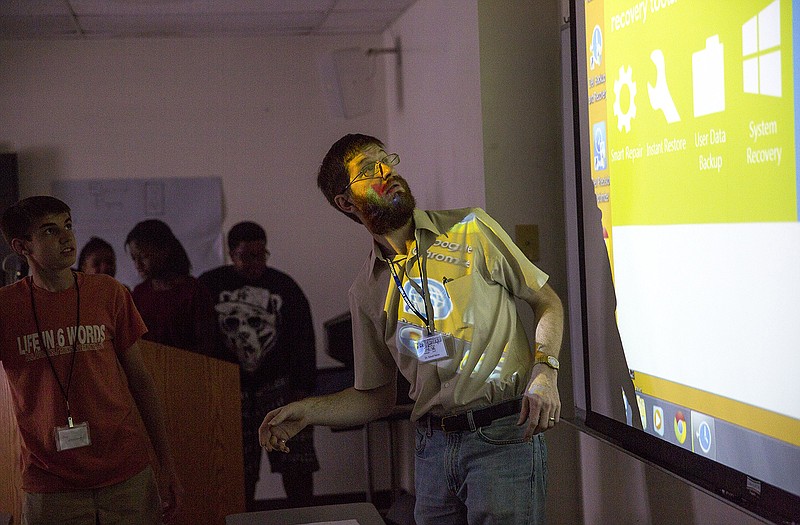One group performed a tune, using a smart phone for the back-up music, plus a flute.
And Coke bottles - each filled with liquid to a different level.
A couple of other groups hit a key and the computer played a tune, while those in the audience looked at a screen to see the "codes" necessary to tell the computer what to play - and how.
And the students performing these musical bits were applauded by their parents, other relatives and their teacher.
Those presentations ended last week's four-day "Music and Math Camp" at Lincoln University, attended by 15 mostly Mid-Missouri students, and taught by David Heise, Ph.D., an assistant professor of computer science.
(Pronounced HIGH-see - no one made a joke about a soprano's high notes.)
"This camp started because I had a student, two-plus years ago, who was working with me to develop some ideas to encourage STEM activity - science, technology, engineering and math," Heise told the News Tribune after the presentations. "We had given a presentation to an external evaluator, for a grant that we had about this idea of hosting a summer camp to encourage students to have a greater interest in STEM.
"And in that conversation, the evaluator said, "Hey! You should do that camp - and you should look to this agency to see if you can get some funding.'"
"That group" was the Mathematical Association of America - which this year is "celebrating (its) century of advancing mathematics" - and, Heise said, "They have a funding source called "Tensor SUMMA,' with SUMMA standing for "Strengthening Underrepresented Minority Mathematics Achievement.'"
The MAA provided a three-year grant.
"One of the big purposes in the camp is to inspire interest in mathematics and to inspire the connections between that and music," Heise said. "The point is to inspire them - even if they don't leave liking math, maybe to appreciate it a little more when they're done with the week."
Two of the students we interviewed were ready to come back, and encourage others to attend.
"I actually like music, but I wasn't really much into the math thing," Princess Garner, 14, said. "But my mom told me about it and I said, "Sure! Why not?'
"I was expecting something a lot different - but it was actually, like, fun!"
Garner will be a freshman at Simonsen 9th Grade Center this fall.
She learned a lot about "how math relates to music," Garner said. "I knew it a little bit, but I didn't, actually, fully understand it until now.
"And that's probably the best part about this."
Ify Anunoby, 15 - who is going into the 10th grade at Jefferson City High School - agreed.
"I liked both math and music - but I had started to, kind of, shy away from math a little bit," she said, "so coming here actually helped me with math a lot more.
"We learned a few things that I hadn't learned yet and, I hope, it will make it a lot easier for me to go through that in school."
She was interested in the Math and Music camp after attending "a Math Day for Girls here at Lincoln," Anunoby said, "and I took a small class based on this - and I really liked it.
"So I wanted to try it again."
During their end-of-the-camp presentations, several of the students noted they had learned the same note - say, an "A" - doesn't look or sound quite the same, when it's played on different instruments, like a guitar, piano or clarinet.
"We did look at some spectograms, looking at the visual representation of sound in the frequency domain, to show visually how a guitar sounds different from a piano sounds different from a clarinet, and so on," Heise said. "So, looking at that, you're right - an "A' is not just an "A.'
"You have different sets of harmonics. You have different transients. You have different aspects of sound that make one instrument sound different from another.
"And, yet, we still use pitch - which often refers to a fundamental frequency."
None of the students said combining math with music had hurt their appreciation for either.
"I have a former graduate school colleague - he's now at Michigan State - who sort of dislikes applying technology to music, because he feels that music is a human endeavor and we shouldn't be applying technology to generate music," Heise said.
"And to some extent, I agree. But I would, also, say that if you use technology to analyze music and you use mathematics to better understand music - it is absolutely fascinating the relationships that you find."
The camp is designed for high school students - those going into ninth grade through those who just have graduated.
The Mathematical Association's three-year grant came with an encouragement to find other funding sources that can delay the implementation of the third year.
So a National Science Foundation grant paid for this year's camp, and "I already have secured funding, again from the same National Science Foundation grant for next year, so next year's covered," Heise said.
"So, for at least the next two years, I anticipate that funding is secured and, obviously, I'll be looking for other opportunities between now and then to continue into the future."
Heise added: "From the experience I've had so far - it's a lot of work but it's also, I think, a very good experience for the students."

